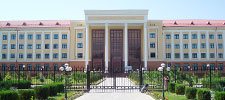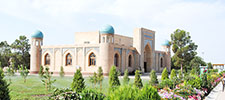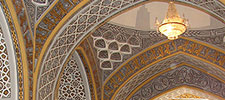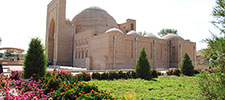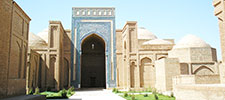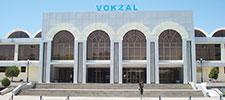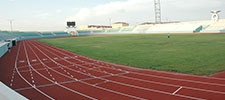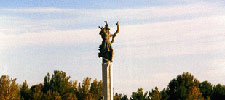About Termiz city
At present Termez is one of the ancient flourishing cities of Uzbekistan like Samarkand, Bukhara, Khiva and Tashkent. If you trip 700 km from Tashkent through the uzbekhigway, which is constructed along with the Great Silk Road, you will arrive in Termez the adminstrative, economic, and cultural center of Surkhandarya region. The population of Termez is 141,5 thousand people. Its territory is 27,1 sq. km. The city is situated on the right bank of Amu Darya river.
The main transit connecting Uzbekistan with neighboring countries Afghanistan, Pakistan, India and other countries passes through Termez. It plays significant role in political and economic life of the city. Termez is the southern gateway of our independent country. It received its status as a city in 1929. Surkhandarya region was founded on March 6, 1941, and Termez has been the center of the region since then. Consistent with archeological information, Termez was formed as a city in the 5th century BC. The historian Hofizi Abru wrote that the city name was originated from the word “Taramastha” (the destination on the other bank of baqtrchanarigi) and it had various names such as Antiohia, Demetrias, Tarmita, Tarmid, Tarmiz, Ta-mi, Tamo. Since 10th century it was called Termez. The followingswere written in “Hududul-Olam” (The boundaries of world countries): “Termiz is an attractive and flourishing city on Jaykhun River (Old name of Amu Darya). Its fortress is on the bank of river and its big bazaar is popular. The people of Khuttalan and Chaganyan traded here”. Till Arabian conquest Buddhism was practiced in Termez andrulers with the title of “Termizshoh” (The king of Termez) reigned the city. In the period of Arabian conquest (689-704) Termez was big fortress in the form of square, which had territory about 70 hector. Time by time Termez was a part of Gaznavids, Karakhanids, Karakhitayids, Saljukids, Kharezmshahs'. As a result of Mongol invasion, in 1220, the city was destroyed. Inaccordance with the writings by Sharafiddin Ali-Yazdiy's “Zafarnama”, the people of Termez strongly resisted against Mongols and for the very reason the city was named after “Madinatur-Rijol” (The city of the brave). In 1407 Miranshah'sson Halil Sultan (1384-1411) rebuilt Termez city.
The following yearsTermez was nearly destroyedduring the intestine wars. Only Pattakesar and Salihabad villageswere not destroyed. In 1894 the Russians built a fortress in Pattakesar village, which was 8 kilometer away from ruins of old Termez.The native population named it “Tuproqqurgon”. Present day Termez is situated on the mentioned Tuproqqurgon fortress. In the years of independence 2500 year old Termez became newly-born, renewed, and splendid. It changed into attractive and flourishing land. We are very proud of our great past and present day. The cities and towns we built make us famous around the world, don't they? Owing to our president's great attentionto our brave frank people, the city has developed and become prosperous and charming.Thanks to our president's objective estimation ofthe city's rich history and its significant role in the world development, the national values were regained; city architecture is reformed; reconstruction, industry development, and business are taken place in city life. It is worth to mention that commercial and business activities have been formed as a result of attention to the city. Joint enterprises have been established. The Cabinet of Ministers of the Republic passed decrees on “The celebration of 1000 year anniversary of “Alpomish” epos” and “Preparation and observation of the 2500 year anniversary of Termez city”, which are worth to mention. Termez Archeological Museum, which is considered the one of the type in Central Asia, have become unique school and striking class for nativesand world historians, as well.“It turned to be precious encyclopedia, which can equal with the levels of Louvre of the Paris and Hermitage of Saints Petersburg.”assumed Kyudzo Kato, a Professor from Japan. Visiting the museum no doubts about the greatness of Uzbek history are left in people's mind.
Today Termez is shining and flourishing city. It is land of sincere wishes and successful duties. In the last years more than 100 historical architectural places have been registered. One of the 96 sheikhs in Islam world, the founder of “Hakimiya” tariqat(the way) and encyclopedic scholar Al-Hakim At-Termizi's and about 40 Termizi scholars' lives and works have been learned. Their graves have become the pilgrimage and visiting places. Great scholar Al-Hakim At-Termizi is regarded as one of the worldly famous countrymen. In the sources such as “Kashful-mahjub”, “Tazkuratul-avliyo”, “Kitob at-taaruf”, “Risolayiqushayriya”, “TabaqotiSullamiy”, “TabaqotiSabkiy”, “Nafahotuluns”, “Nasoyimul-muhabbat” his full name is Abu-Abdulloh Muhammad ibn Ali Hasanibn Bashr al-Hakim at-Termiziy. Fayaz-tepa was an advanced post of Buddhism Fayaz tepa bears withess to a key period of the region’s history, during which the encounter of Buddhist and Greek cultures took place.
The excavations which the Archeological Expedition discovered comprised a large rectangular monastery faced by a stupa, located on the north-eastern part of the site.The complex has three main units: the southern unit (A) containing accommodation for pilgrims including dining rooms and kitchens; the main monastery (B) situated in the centre; and the northern unit (C), probably used for lectures and ceremonies. The central part (B) is built around a courtyard (30x20), surrounded by a colonnade and a series of rooms. Units A and C also featered a number of internal courtyards and colonnades. The overall building was laid on a gravel layer, avoiding humidity in the Pakhsa (hand-shaped mud) walls, which were about 1.4 m thick and up to 4.5 m high. Roofs featured barrel vaults made of sun-dried mud bricks (adobe) over the enclosed spaces, and flat roofs supported by wooden beams over the colonnades. Fayaz tepa was built during the reign of the Kushan Kings (ist to 3rd centuries CE). One of the characteristics of this site is the quality and the good state of conversation of the remains unearthed, the variety and richness of the artifacts and wall paintings discovered, which represent an exceptional testimony of Kushan period art, with clear influences from both Buddhist and Greek cultures. The cult complex of Koratepa is one of the world’s oldest surviving Buddhist cave monasteries To the northwest of Termez.., on the left bank of Amu Darya river, there is a three-head hill. The local people call it Koratepa, which means “Black Hill”. From its southern, the highest point one can clearly observe the citadel, surrounded by walls, and the ruins of the ancient town. The first archeological excavations took place at Koratepa in 1936. They proved that centuries-old loess cultural layers hide a temple complex witch cave monastery, founded by Buddhist monks at the of the 1st century. In the underground chambers archeologists found fragments of statues of Buddha and Bodhisattvas, statuettes of dragons and of a winged lion, as well as wall paintings with one of the world’s oldest images of Buddha surrounded by monks. On the same walls there are portraits of donators, who were rich enough to order the construction of the temple. In the cells there were found ceramic lamps, reliquary boxes, coins of the times of Kanishka I and the Sassanid rulers. Koratepa complex also had a vihara (‘dwelling’ in Sanskrit) - a dormitory, where pilgrims could take shelter. The walls of this dormitory bear the surviving graffiti picture of a Buddhist stupa. The Chinese monk Xuan Zang, who made a pilgrimage to India early in 7th century in search of holy Buddhist books, mentioned his visit to shrines of Koratepa in his famous travelogue “Records of the Western World”. Over the last ten years Uzbek and Japanese experts have done joint archeological research at Koratepa.

